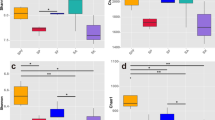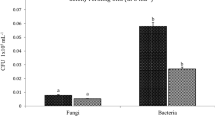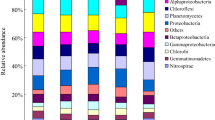Abstract
A functional pesticide–fertilizer combination is in high demand due to the many potential advantages, including the dual reduction in pesticide and fertilizer inputs, increased crop yield, safe to use, and environmental friendly. To investigate the impact of a pesticide–fertilizer on the soil environment of sugarcane, the effects of clothianidin and/or organic fertilizer treatments on the diversity, structure, and function of the rhizosphere bacterial community were studied using 16S rRNA gene sequencing in 2019 at Guangzhou Sugarcane Research Institute. The bacterial community treated with the pesticide–fertilizer displayed a higher diversity compared with the control treatments (added with pesticide or fertilizer only). The dynamic changes of the bacterial community structure revealed that the pesticide–fertilizer treatment showed a significant variation in the second week. Functional analysis demonstrated that four bacterial genera, including Dyella, Mucilaginibacter, Massilia, and Telmatospirillum, could play an important role in degrading clothianidin and improving soil health. The relative abundance of nitrogen cycle genes showed that the nitrification-related gene pmoA-amoA and denitrification-related genes nirK and norB were increased significantly in the pesticide–fertilizer treatment compared with that of the control treatments. This preliminary study provides a good basis to understand the effect of a pesticide–fertilizer integration on the soil rhizosphere microbiome which would be helpful for the evaluation of its application in the field.







Similar content being viewed by others
References
Achorn, F.P., and E.B. Wright. 1982. Production of fertilizer-pesticide mixtures. ASTM special technical publication, USA, 764: 18.
Bakker, M.G., D.K. Manter, A.M. Sheflin, T.L. Weir, and J.M. Vivanco. 2012. Harnessing the rhizosphere microbiome through plant breeding and agricultural management. Plant and Soil 360 (1–2): 1–13. https://doi.org/10.1007/s11104-012-1361-x.
Cai, F., G. Pang, R.X. Li, R. Li, X.L. Gu, Q.R. Shen, and W. Chen. 2017. Bioorganic fertilizer maintains a more stable soil microbiome than chemical fertilizer for monocropping. Biology and Fertility of Soils 53 (8): 861–872. https://doi.org/10.1007/s00374-017-1216-y.
Cherry, R., M. Mccray, and H. Sandhu. 2017. Changes in the relative abundance of soil-dwelling insect pests in sugarcane grown in Florida. Journal of Entomological Science 52 (2): 169–176. https://doi.org/10.18474/JES16-33.1.
Diez, M.C., S. Elgueta, O. Rubilar, G.R. Tortella, H. Schalchli, C. Bornhardt, and F. Gallardo. 2017. Pesticide dissipation and microbial community changes in a biopurification system: influence of the rhizosphere. Biodegradation 28 (5–6): 1–18. https://doi.org/10.1007/s10532-017-9804-y.
Doolotkeldieva, T., M. Konurbaeva, and S. Bobusheva. 2018. Microbial communities in pesticide-contaminated soils in Kyrgyzstan and bioremediation possibilities. Environmental Science and Pollution Research 25: 31848–31862. https://doi.org/10.1007/s11356-017-0048-5.
Endres, L., N.G. Oliveira, V.M. Ferreira, J.V. Silva, G.V. Barbosa, and O.M. Sebastião. 2016. Morphological and physiological response of sugarcane under abiotic stress to neonicotinoid insecticides. Theoretical and Experimental Plant Physiology 28: 347–355. https://doi.org/10.1007/s40626-016-0056-8.
Franco, H., R. Otto, C.E. Faroni, C.V. André, C. Emídio, and P. Trivelin. 2011. Nitrogen in sugarcane derived from fertilizer under Brazilian field conditions. Field Crops Research 121 (1): 29–41. https://doi.org/10.1016/j.fcr.2010.11.011.
Guan, H., H.L. Huang, Y.J. Xing, X.S. Li, H.H. Tan, and D.Q. Zeng. 2015. Residue and degradation dynamics of clothianidin in sugarcane and soil. Modern Agrochemistry 14 (2): 42–45.
Hartmann, M., B. Frey, J. Mayer, P. Mäder, and F. Widmer. 2015. Distinct soil microbial diversity under long-term organic and conventional farming. ISME Journal 9 (5): 1177–1194. https://doi.org/10.1038/ismej.2014.210.
Hassen, W., M. Neifar, H. Cherif, M. Mahjoubi, Y. Souissi, N. Raddadi, F. Fava, and A. Cherif. 2018. Assessment of genetic diversity and bioremediation potential of pseudomonads isolated from pesticide-contaminated artichoke farm soils. 3 Biotech 8 (6): 263. https://doi.org/10.1007/s13205-018-1256-5.
Huang, W.J., D.L. Sun, J.T. Fu, H.H. Zhao, R.H. Wang, and Y.X. An. 2020. Effects of continuous sugar beet cropping on rhizospheric microbial communities. Genes 11: 13. https://doi.org/10.3390/genes11010013.
Javaid, M.K., M. Ashiq, and M. Tahir. 2016. Potential of biological agents in decontamination of agricultural soil. Scientifica. https://doi.org/10.1155/2016/1598325.
Jin, S.Q., and F. Zhou. 2018. Zero growth of chemical fertilizer and pesticide use: China’s objectives, progress and challenges. Journal of Research Ecology 9 (1): 50–58.
Klaine, S.J., M.L. Hinman, D.A. Winkelmann, K.R. Sauser, J.R. Martin, and L.W. Moore. 2010. Characterization of agricultural nonpoint pollution: pesticide migration in a West Tennessee watershed. Environmental Toxicology and Chemistry 7 (8): 609–614. https://doi.org/10.1002/etc.5620070802.
Mamta, R.J.R., and A.W. Khursheed. 2015. Bioremediation of pesticides under the influence of bacteria and fungi Chapter 3, Source Title: Handbook of Research on Uncovering New Methods for Ecosystem Management through Bioremediation, pp. 51–72.
Polivkova, M., J. Suman, M. Strejcek, M. Kracmarova, M. Hradilova, A. Filipova, T. Cajthaml, T. Macke, and O. Uhlik. 2018. Diversity of root-associated microbial populations of Tamarix parviflora cultivated under various conditions. Applied Soil Ecology 125: 264–272. https://doi.org/10.1016/j.apsoil.2018.02.002.
Prashar, P., and S. Shah. 2016. Impact of fertilizers and pesticides on soil microflora in agriculture. In Sustainable agriculture reviews, vol. 19, ed. E. Lichtfouse. Cham: Springer.
Ramasubramanian, T. 2013. Persistence and dissipation kinetics of clothianidin in the soil of tropical sugarcane ecosystem. Water, Air, and Soil pollution 224 (3): 1–5. https://doi.org/10.1007/s11270-013-1468-6.
Schmitz, J., M. Hahn, and C.A. Brühl. 2014. Agrochemicals in field margins—an experimental field study to assess the impacts of pesticides and fertilizers on a natural plant community. Agriculture Ecosystem and Environment 193: 60–69. https://doi.org/10.1016/j.agee.2014.04.025.
Velasco, A., J. Rodríguez, R. Castillo, and I. Ortíz. 2012. Residues of organochlorine and organophosphorus pesticides in sugarcane crop soils and river water. Journal of Environmental Science Health 47 (9): 833–841. https://doi.org/10.1080/03601234.2012.693864.
Xie, S., H. Feng, F. Yang, Z. Zhao, X. Hu, C. Wei, T. Liang, H.T. Li, and Y.B. Geng. 2019. Does dual reduction in chemical fertilizer and pesticides improve nutrient loss and tea yield and quality? A pilot study in a green tea garden in Shaoxing, Zhejiang Province, China. Environmental Science and Pollution Research 26 (3): 2464–2476. https://doi.org/10.1007/s11356-018-3732-1.
Zhao, L.J., Y.H. Jia, J.T. Zhou, A. Li, and J.F. Chen. 2010. Dynamics of augmented soil system containing biphenyl with Dyella ginsengisoli LA-4. Journal of Hazardous Materials 179: 729–734. https://doi.org/10.1016/j.jhazmat.2010.03.062.
Zhu, S., J.M. Vivanco, and D.K. Manter. 2016. Nitrogen fertilizer rate affects root exudation, the rhizosphere microbiome and nitrogen-use-efficiency of maize. Applied Soil Ecology 107: 324–333. https://doi.org/10.1016/j.apsoil.2016.07.009.
Acknowledgements
This work was funded by GDAS’ Project of Science and Technology Development (2019GDASYL-0103031), and National Key R&D Program of China (2018YFD0201103).
Author information
Authors and Affiliations
Contributions
WH and YA designed the experiments. DS and LC collected materials, while WH, SD, and LC performed the experiments. WH, DS, and YL analyzed the data. WH wrote the article. WH and YA revised the article.
Corresponding author
Ethics declarations
Conflict of interests
The authors declare that they have no competing interests.
Availability of Data and Material
All the metagenome sequences were uploaded to NCBI with the submission number SUB6197284.
Code Availability
Not applicable.
Consent to Participate
All authors have participated in this work.
Consent for Publication
All authors have approved publication.
Ethics Approval
All authors have approved submission of the enclosed manuscript for consideration of publication.
Additional information
Publisher's Note
Springer Nature remains neutral with regard to jurisdictional claims in published maps and institutional affiliations.
Electronic supplementary material
Below is the link to the electronic supplementary material.
Rights and permissions
About this article
Cite this article
Huang, W., Sun, D., Lu, Y. et al. Effects of Pesticide–Fertilizer Combinations on the Rhizosphere Microbiome of Sugarcane: A Preliminary Study. Sugar Tech 23, 571–579 (2021). https://doi.org/10.1007/s12355-020-00914-y
Received:
Accepted:
Published:
Issue Date:
DOI: https://doi.org/10.1007/s12355-020-00914-y




